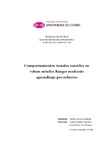Comportamientos visuales sencillos en robots móviles Ranger mediante aprendizaje por refuerzo

Use this link to cite
http://hdl.handle.net/2183/31884
Except where otherwise noted, this item's license is described as Atribución-NoComercial-CompartirIgual 3.0 España
Collections
Metadata
Show full item recordTitle
Comportamientos visuales sencillos en robots móviles Ranger mediante aprendizaje por refuerzoAuthor(s)
Directors
Regueiro, Carlos VPardo, Xosé Manuel
Date
2022Center/Dept./Entity
Universidade da Coruña. Facultade de InformáticaDescription
Traballo fin de grao (UDC.FIC). Enxeñaría Informática. Curso 2021/2022Abstract
[Resumen] En este trabajo se desarrolla un sistema que permite generar, mediante aprendizaje por
refuerzo, comportamientos basados en las imágenes capturadas por una cámara en un robot
capaz de moverse por sí mismo.
A parte de un robot real (Formado por una Raspberry Pi 3 y el robot educativo Makeblock
Ranger) se usó el simulador de robótica Webots, que facilitó el desarrollo gracias a que presenta
un entorno controlado en el que se puede automatizar el aprendizaje.
Los robots reciben estímulos mediante sensores, de forma automática, o manualmente,
mediante la pulsación de un botón por parte de un operador humano, para así obtener un
refuerzo con el que aprender el comportamiento deseado.
De esta forma, y centrándonos en la tarea de seguir una línea a través de un circuito
cerrado, desarrollamos dos controladores:
El primero se sirve del algoritmo de Q-Learning para aprender el comportamiento, y se
ayuda de técnicas de visión por computador para detectar la línea y parametrizarla. El segundo
controlador se sirve de Deep Q-Learning para, tomando la imagen capturada por la cámara,
identificar por si solo los elementos importantes y actuar en consecuencia.
Ambos controladores se han desarrollado con una estructura modular, de forma que se
puedan editar esos módulos para adaptarlos a otras tareas y otros entornos de ejecución. [Abstract] In this project, a system is developed that allows generating behaviors through reinforcement
learning, based on the images captured by a camera in a robot capable of moving by
itself.
Apart from a real robot (consisting of a Raspberry Pi 3 and the Makeblock Ranger educational
robot) the Webots robotics simulator was used, which facilitated development thanks
to a controlled environment where learning could also be automated.
The robots receive input either automatically, through sensors, or manually, by a human
operator pressing a button, all in order to obtain a reinforcement with which to learn the
desired behavior.
In this way, focusing on the task of following a line through a closed circuit, we developed
two controllers:
The first uses the Q-Learning algorithm to learn the behavior, and uses computer vision
techniques to detect the line and parameterize it. The second controller uses Deep Q-learning
and, by taking the image captured by the camera, identifies the important elements on its
own and acts accordingly.
Both drivers have been developed with a modular structure, so that those modules can be edited to suit other tasks and runtime environments.
Keywords
Aprendizaje máquina
Aprendizaje por refuerzo
Q-Learning
Deep Q-Learning
Comportamiento visual
Robótica móvil
Visión por computador
Raspberry Pi
Machine learning
Reinforcement learning
Visual behaviour
Mobile robotics
Computer vision
Aprendizaje por refuerzo
Q-Learning
Deep Q-Learning
Comportamiento visual
Robótica móvil
Visión por computador
Raspberry Pi
Machine learning
Reinforcement learning
Visual behaviour
Mobile robotics
Computer vision
Rights
Atribución-NoComercial-CompartirIgual 3.0 España






